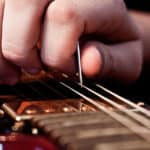Having a practice routine is so important when it comes to growing your musical skill.
The big problem for most musicians is that we tend to practice sporadically and without any structure.
Let’s look at how to prevent that and which routine can help you depending on your level.
We’ll be checking out a routine for each level of guitar, each one getting more complex as we go, but they all revolve around the fundamentals and developing them at each level.
Whether you’re a beginner or an experienced player, there’s always something you can learn.
Hopefully, by the time you’ve finished this article, you’ll have a new bag of tricks to try out.
How important is having a proper guitar routine?
Having a proper routine Is the difference between a plateauing guitarist and a growing guitarist.
It’s the difference between an okay player and an exceptional one.
The reason why we need to have a good routine is that it gives us consistency and accountability.
If you wind up 6 months down the line and have made no progress, you can then hold yourself accountable and begin to iron out flaws in your routine.
So then it becomes less of a mystery why you suck and more clear.
You can say “Oh, I see I haven’t been practicing regularly, but I also have no goal when I practice, so I just go off on tangents.”
The point of routines is to chunk up your goals into manageable steps and progression.
You might start with a simple practice routine for lead guitar by doing a chromatic scale until you can reach 140 bpm at 16th notes.
Then from there, it opens you up to do more demanding things.
The core of it is that you identify goals, set out methods of achieving those goals, and then stick to them. And a practice routine is perfect for that.
What is a good guitar routine?
A good guitar routine is one with a long-term approach and a sustainable approach.
This means that you’re not trying to cram 8 hours of practice into one day a week, but rather splitting that up into 1-hour sessions across the week.
You’ll see way more progress this way because you give your brain time to retain what you’ve learned while also avoiding over-strain injury.
Another aspect of a good routine is that it tackles multiple aspects of guitar skills throughout the cycle of the routine.
I like to think of it like a gym routine.
Imagine spending 5 hours a day working the same muscle, or spending five days a week on the same muscle…
The same mental picture can be formed for practicing guitar.
Monday might be focused on scales and how to use them creatively, Tuesday could be focused on speed exercises, Wednesday could be focused on implementing harmonics, and so on.
I will say however that with any practice routine, there should be a consistent warm-up exercise.
For me, that’s usually ascending the neck string by string on the chromatic scale and then ascending and descending the strings the same.
It just works for me and gets my fingers geared to play independently,
I also like to use songs that challenge me as a way to improve my practice by using the song to implement what I’ve learned.
For instance, The sound of Truth by As I lay dying is a great song with a lot of technical skills to be learned.
You have the intro which requires consistent timing, but then the second verse changes from 16th notes to 12th notes.
The lead line has this galloping rhythm to it with a lot of quick changes between strings and then it jumps into this massively stretched tapping melody.
Essentially, the song reinforces what I’m already working on, plus it’s a fun treat for my diligent brain.
Defining goals for your routine
Goals are like the road map for your routine.
If you just decide to work on a couple of things without any real end in sight, you’ll lose motivation really quickly too.
The best approach is to think about your weak spots and then find exercises that cover them.
Then you think about how these weak spots will develop into branching skills over time and then try to plan for those.
That’s not to say that you have to plan your routine ten years in advance, but think of it like this: if you know you’ll be working on strumming and rhythm, you can think about moving from the basic rhythm to more challenging strumming patterns down the line and set a deadline and target for when you should progress.
A practice routine without a goal in mind is just noodling, so think about your goals and write them out.
If you struggle with planning such things, don’t worry, there are tons of resources.
How to measure your guitar progress
The best way to measure progress is to have goals and routines that are measurable.
Here’s an example: you’re learning a song, but you can’t play the lead riff yet.
Do you …?
- A: practice the song at full speed and stumble and become frustrated, or
- B: Learn the riff at half speed and then incrementally increase the speed until you’re at the original BPM.
Option B. Option B is the correct option.
When you take this approach, it means you can start from where you’re capable and then slowly stretch your capabilities.
Again to the exercise routine analogy. If you want to get strong, do you walk in and try to lift what the pro bodybuilder is lifting, or do you find something that won’t injure you and build up from there?
The same is true for guitar progress. In fact, a lot can be learned from fitness buffs about how to create measurable routines.
The point is to do exercises that hit on multiple aspects of your skills at least twice a week and then you’ll begin to see progress.
Different things to practice
As I was saying before, you can’t just work one muscle and expect to become strong.
In the same sense, you can’t practice one exercise and expect to become a good guitar player.
When starting out, you should focus first on the fundamentals:
- Good posture
- Good finger technique
- Basics of picking and pentatonic scale
- Working on hand synchronization
- Basic chord shapes and simple rhythm
Multiple aspects make up a skilled musician
once you master the fundamentals, you can start moving on to more complex things and start involving music theory.
I’d say an intermediate guitar player would focus on things like:
- Good finger technique
- More advanced scale patterns and shapes
- Alternate picking and higher tempo
- More advanced rhythms like folk rhythms
- Not just chord shapes, but studying how chords are built up and learning about chord inversions
The list goes on and it can be quite extensive.
Guitar practice routines for beginners
1. Basic Posture
Basic posture is about how you hold the guitar, about comfort, and about being able to maneuver along the fretboard without any hindrance to yourself.
Basic posture has to do with:
- How you sit
- How you hold the guitar
- How you angle the neck of the guitar
- How you position your hands
Good posture looks something like this:
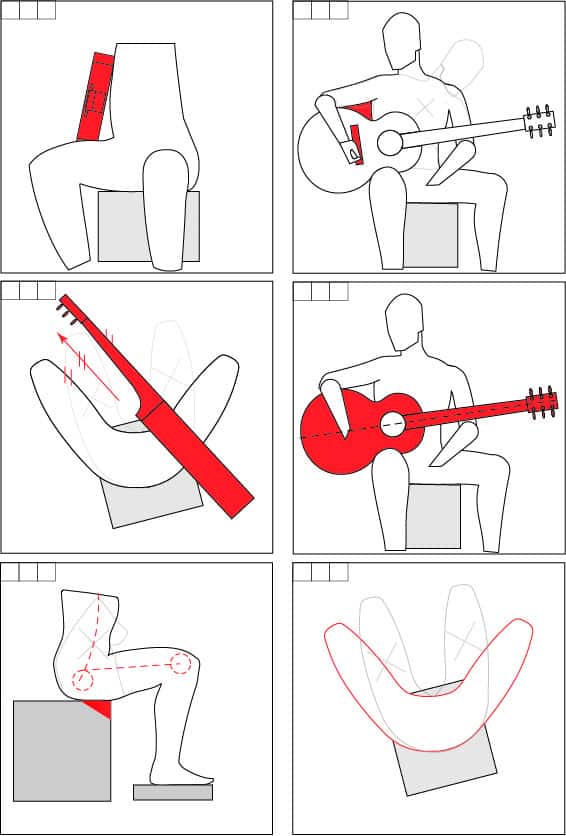
2. Basic picking patterns and learning the fretboard
At this stage, you need to be careful not to get carried away trying to do “the cool stuff.”
The important thing is being able to quickly find the 7th fret without too much thought and then back to the 3rd and so on.

Secondly is being able to pick the strings and the notes without any muting or asynchronous playing.

Meaning, when your right-hand picks, your left hand should be on the note. This becomes very important later because it refers to a concept called transition time.
3. Alternating between strings
Next is getting comfortable with picking patterns that alternate between strings.
This is important because most beginners develop bad habits here when it comes to picking and how they pick.
The right hand should move comfortably between strings
Here are some exercises you can do:

4. Simple songs with straight rhythms
Timing is everything in music and as a beginner, you will have a hard time getting the hang of any rhythm that isn’t based on simply keeping time.
The best way to practice this is with a metronome.
You want to be able to play each note exactly on the metronome.
Here are some rhythm exercises you can try:
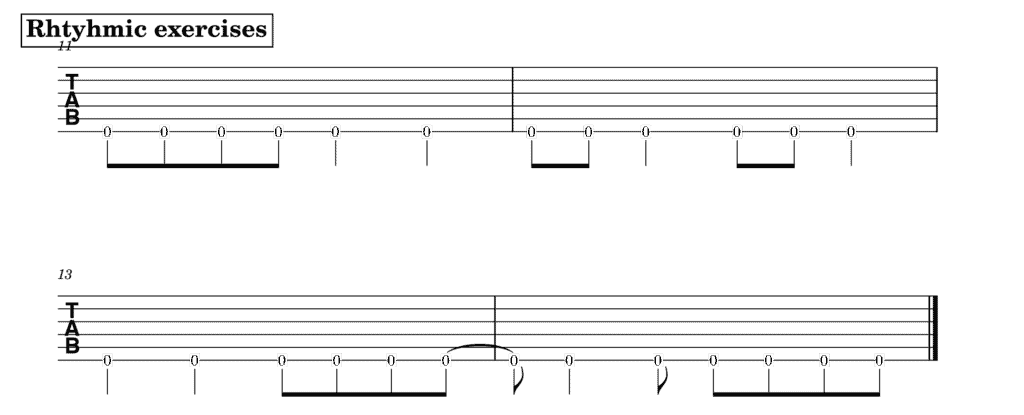
5 Basic Open chords
When I say basic chords, I’m referring to open chords that require little movement.
The easiest chords to learn for a beginner are chords in C and G major.
I’ve listed the basic chords you should get a handle on before progressing.
More than just being able to play the chords, there is the need to be able to switch between them with the proper timing.
So exercises are needed for switching between chords.
Back to the metronome; you will need to practice switching between chords within each beat.
For this exercise, you pick two chords and practice switching between them and taking note of how your hand has to change shape as you go.
A simple trick: some fingers don’t change position and I like to think of them as anchors.
For instance, switching from A minor to F to C.
The index finger acts as an anchor or pivot between these chords, maintaining your stability while you switch around with the other fingers.
Guitar practice routines for intermediate players
1. Hammer-Ons and pull-offs and doing them properly
The next step for bettering your skill as a musician is to start implementing legato style playing or playing where the left hand is responsible for sounding notes.
This can later become much more advanced, especially with electric guitar, but let’s start simple.
This exercise is designed to strengthen your fingers so that you’re not only more accurate with your left hand but also becomes stronger.

The next exercise focuses more on your left hand doing pull-offs.

The key to proper pull-offs is that you hook your finger a little while you’re pulling your finger off the fret. The action of the finger itself should create the sound.
The cool thing about hammer-ons and pull-offs is that they allow you to start playing faster too.
2. Alternate picking
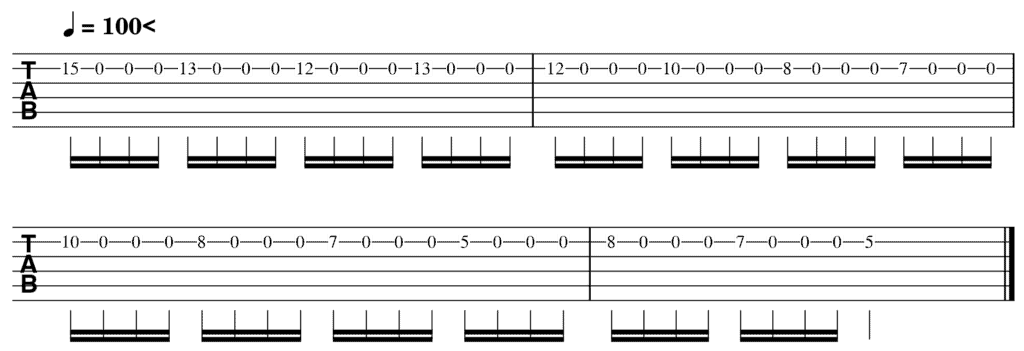
Alternate picking and hammer-on/pull-offs go hand in hand.
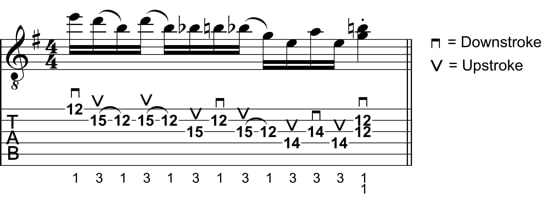
How?
Well, it doesn’t help for you to have a fast left hand and a slow right hand.
While you’re developing your legato, you should also do the same exercises, but with the right-hand picking being the emphasis.
The second aspect is applying this to finger exercises and scales.
3. Learning scales and the notes of the fretboard
Exercises are one thing, but you won’t be able to play music if you don’t know what key you’re playing in or which scale you’re using.
Knowing the fretboard is good, but you need to know which notes you’re playing on the fretboard.
This becomes a bit of an exercise of memorization though, but there are some cool exercises you can try:



I’ve written a post on scales you can learn to get you started playing cool stuff really fast, so I won’t go into too much detail about how they work here.
But your basic scales will be the pentatonic scales and the major and minor.
4. Diatonic scale routines
Ascending and descending the scales is one thing, but playing them well requires that you’re able to move between the notes nimbly and easily.
Here are exercises for that:
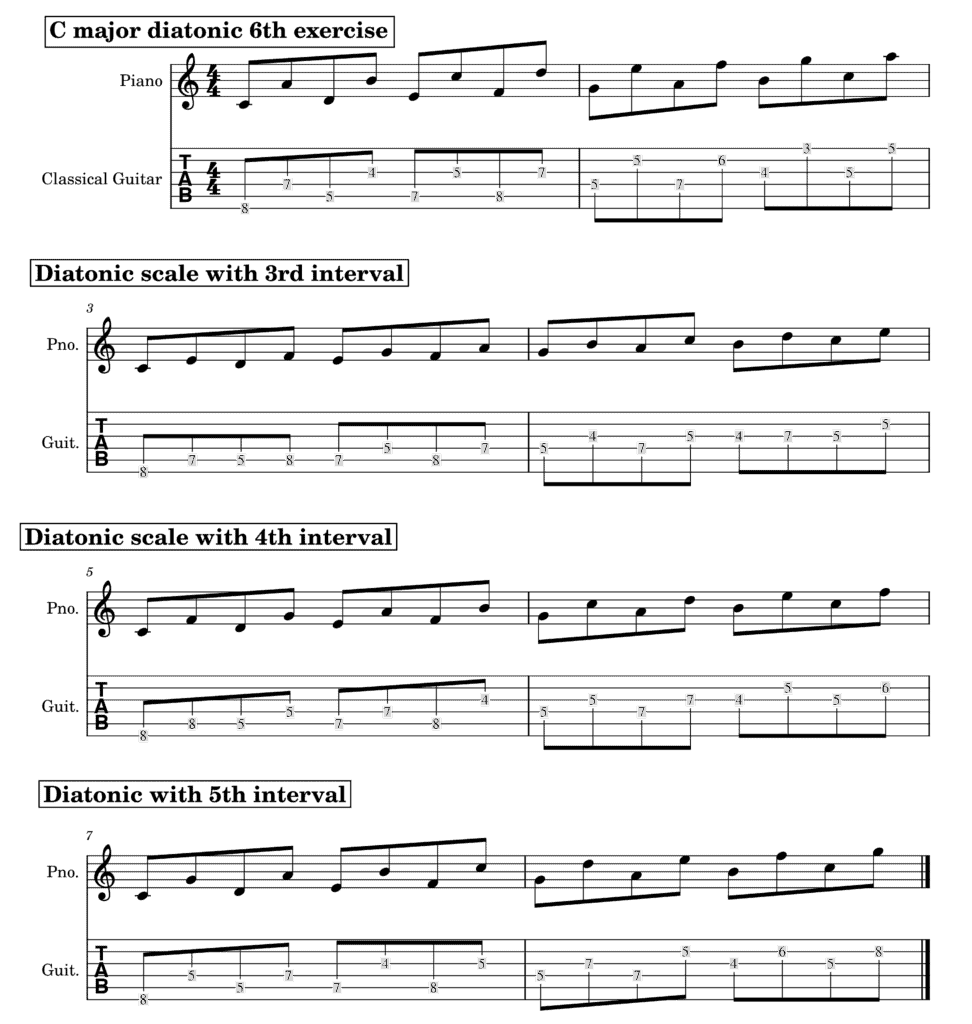
5. Songs with a mixture of rhythm and lead
Mixing lead and rhythm has always been a staple of musical skill.
A lot of songs have a simple mixture like I love rock n roll. If you look at some of Ed Sheeran’s music, you’ll find the same.
Here are some exercises you can do that mix rhythm and lead.

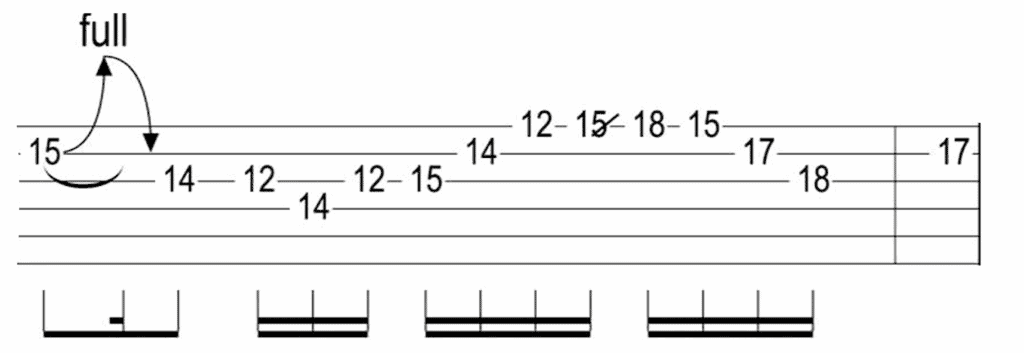
The important thing is that you keep your timing on track.
6. Barre chords and chord inversions
Open chords are easy enough to play, most intermediate guitar players can also play power chords and some shapes along the neck.
Barre chords are what many players struggle with because you’re required to bar every string on the neck as well as make sure each note sounds out.
Chord inversions are simply playing a chord but starting at the second or third note as the lowest note.
For example, with C major, the first inversion is playing C with E as the lowest note, and G would be the third inversion.
Guitar practice routines for advanced players
1. Finger independence exercises
You will need to develop your finger independence if you’re going to play lead.
Here are some exercises to do that:
2. Implementing pinch harmonics into lead
Equally important is learning to do pinch harmonics.
Pinch harmonics are played by angling your picking fingers so that the thumb catches the string as soon as you’ve picked it.
What this does is eliminate the lower pitch vibrations of the string, leaving you with the harmonic.
You’ll need an electric guitar for this kind of playing and it takes a bit of practice too, so it’s good to use a scale to practice making sure each note is played as a harmonic.
You will also need a lot of gain and distortion on your guitar.
3. Classical scales and creating melodic licks
A lot of metal bands like to use melodic scales to play their songs.
This adds a bit more complexity to what you’re playing because the melodic scale is different depending on whether you’re ascending or descending it.
They also implement a series of short notes on a scale played together in quick succession, this is usually referred to as a lick.
4. Advanced rhythms (triples, pentuplets, and mixing the bunch)
You can also implement advanced rhythms into your practice routine.

Advanced rhythmic exercises are a bit tough at first because you have to learn to play odd meters in time.
A lot of guitar players often have trouble spacing out the notes, but there are plenty of routines to try this out.
As always, use a metronome when practicing your timing.
5. Hand synchronization with sweep picking
Sweep picking is often considered one of the hardest things to play on guitar, but I think it’s because people are really impatient with the process.
Sweep-picking really comes down to muscle memory and accuracy.
Here are some shapes you can try, starting at two strings, then three, and on.
The key is to go through it slowly, then speed up the metronome little by little.
Going up two beats per minute at a time tends to work best.
If you go up in speed and you find your accuracy diminishing, then you should go back down and continue practicing at a manageable rate.
There are many more ways to improve your guitar playing, but that’s really up to your goals.
How long should your guitar practice routines be?
It depends on you and the time you have. It depends largely on your goals as well.
If you’re a hobby guitarist and you just want to master an instrument for the love of it; consistency is still important but there’s more flexibility.
If you’re aiming to be a professional musician, then you might want to take up a part-time job and devote the majority of your day to guitar.
The point is that it will vary from person to person. However, I like to give an average time for different levels that can give you a good yardstick.
For beginners, I’d recommend 20-30 minutes of practice a day.
Because you’re learning something new, you’re not just playing guitar, you’re focusing on good finger posture and all the little things that become subconscious for advanced players. 20-30 mins a day is plenty.
For intermediate players: You’re at the point where playing is more a matter of the notes and the music and less about fighting with your fingers all the time.
You can switch to different chords pretty effortlessly and you know your fretboard. An hour a day will show you fast progress in my opinion.
For advanced players, it becomes a matter of how much time you want to devote to guitar.
You’ll still see results playing for an hour a day, but you’ll find that sometimes that might feel a bit rushed, because of all of the things you’re trying to tackle.
At that point, if you can afford more time, stretch out your routine if you can’t, split up what you’re practicing over the week.
Make sure your routines evolve with time
Remember what I said about weak spots?
As you grow and improve, you’ll build on weak spots but others will develop.
The key to becoming better is to remain aware of those weak spots and to spend time on them, while also balancing keeping your strong points in shape.
I like to think of it like a skill tree in an RPG game.
You’ll inevitably invest more time into skills you prioritize over others.
That’s totally fine, in fact, that’s great. Few guitar players can learn everything, or even have the luxury to.
Evolving your routine is about keeping an eye on your priorities and matching them up with your goals.
Do you want to be an amazing rhythm guitar player, and prioritize rhythmic exercises over learning licks?
Do you want to be a lead guitarist worthy of a stadium, then focus on music theory along with getting those fingers in shape and working independently?
The point is that practice is best used when it’s being directed.
You may not be able to do that for yourself in the beginning, but as your skills grow and your competency along with it, you’ll find you’ll become a better judge of what you need to be doing to improve.

Hello there, my name is Ramiro and I’ve been playing guitar for almost 20 years. I’m obsessed with everything gear-related and I thought it might be worth sharing it. From guitars, pedals, amps, and synths to studio gear and production tips, I hope you find what I post here useful, and I’ll try my best to keep it entertaining also.



